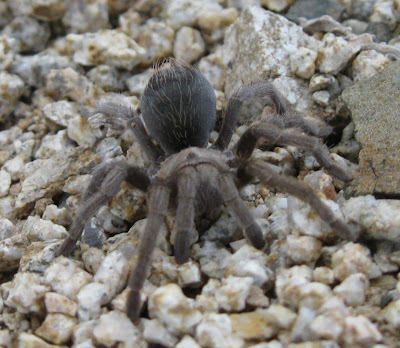This Desert Tarantula, Aphonopelma chalcodes, the first I’ve ever seen, measured just less than 2 inches. Females, up to 2.75 inches with a 4 inch leg span, are typically a little bigger than males. And I didn’t ask what sex it was but read that males are usually black and females brown.

According to the Audubon Guide, the male spider wanders in the dim light after sunset or near dawn searching for a mate, and then hides by day in abandoned holes or under stones. Mike uncovered this tarantula while digging in a pile of gravel.
.jpg)
Tarantulas take up to 10 years to reach sexual maturity. The male tries to maintain contact with the female and if she moves away, he aggressively pursues his desired mate. Females may live up to 20 years.

Tarantulas are reluctant to attack people and this one seemed cold and slow. Usually the venom is no more poisonous than that of bees but I wouldn’t risk that by picking it up.
According to the Audubon Guide, the male spider wanders in the dim light after sunset or near dawn searching for a mate, and then hides by day in abandoned holes or under stones. Mike uncovered this tarantula while digging in a pile of gravel.
.jpg)
Tarantulas take up to 10 years to reach sexual maturity. The male tries to maintain contact with the female and if she moves away, he aggressively pursues his desired mate. Females may live up to 20 years.
Tarantulas are reluctant to attack people and this one seemed cold and slow. Usually the venom is no more poisonous than that of bees but I wouldn’t risk that by picking it up.

.jpg)